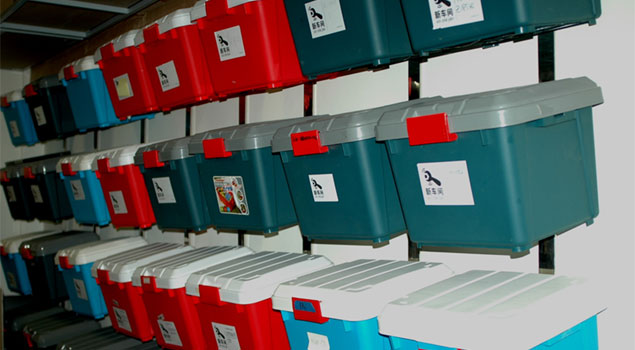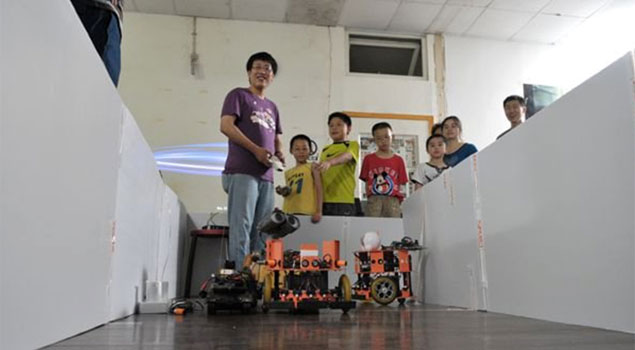
Playing Go. Shanghai, 2006. Source: Wikipedia.
China had earned a reputation as the home of fakes and copies. But following a period of fast-tracked economic and technological growth, the country is now committed to the promotion of creativity and innovation. This impulse can be seen in the flourishing “Maker” movement, supported by the government, as a result of which “Shanzhai” no longer calls to mind “a copy manufactured in Shenzhen” but rather a new kind of innovation based on open source manufacturing and ongoing “remake”.
According to the website of the first hackerspace founded in China, XinCheJian, hackerspaces are communities where people who are interested in physical computing and technology can meet and collaborate on projects. They are places where people can learn and play with technology, work in teams, participate in international competitions, and find and create opportunities for everybody.
XinCheJian was founded in 2010 by David Li along with a few of his collaborators. As Li* recounts, its origins were informal: “XinCheJian started quite innocently. I started experimenting with Arduino, 3D printing, and similar technologies in 2008. As things started to pile up and gradually take over my house, the idea of having a dedicated space began to make sense. We started organising events to talk about makerspaces at XinDanwei, the first co-working space in China, and we attracted quite a lot of interest. I met Minlin Hsieh and Ricky Ng-Adam in 2010 and we decided that it was time to open our own. The name XinCheJian was proposed by Liu Yan, one of the co-founders of XinDanwei. The Chinese word danwei means work unit and, as a collaborative work space, XinDanwei is presumably a new type of work unit; CheJian means workshop and XinCheJian refers to a new way of making and of manufacturing. ”

Project boxes at XinCheJuan. Photo courtesy of Sandra Álvaro and David Li.
These digital fabrication spaces are based around local communities. Although they share a common ethos, they adapt and grow in accordance to the characteristics of the environment in which they are based and the community that sustains them. China is an emerging country where the industrial revolution took place at a rapid pace, in parallel to the implementation of digital technology, generating a huge industrial structure focusing on electronics manufacturing and inspired by a discourse according to which progress goes hand in hand with technological determinism. Against this backdrop, DIY making in China is not linked to a nostalgia for manual production or to the counterculture as in other countries. In this sense, XinCheJian is a hackerspace with Chinese characteristics: “In most parts of the world, makerspaces are either about nostalgia for the manufacturing methods of the past as in the case of the United States and Europe, or a new way of approaching the future, as in Africa. But in China, the factory of the world, manufacturing is now ,it’s the present. Creating a makerspace where people do things for fun in a country where producing is the main economic activity is the principal challenge in both the philosophical and practical sense. This is the reason for creating a Chinese-style makerspace.”
Located in the Jing’an district, one of Shanghai’s largest commercial and entertainment areas, around the corner from the huge shopping malls on Changde Road, XinCheJian occupies part of the ground floor of the XinDanwei premises. It is a nestled space, where tools and project boxes collect around the two big work tables. A monthly fee of 100 CNY or around 15 euros – 130 for access to one of the storage boxes hanging on the walls – entitles members to use the space and all the equipment in it, and, more importantly, to form part of an open, active community. Mostly consisting in withe collar workers with a high educational level, expats, people who are passing through, artists, engineers, designers, programmers, techies, students, and all kinds of people who are interested in making things. They use their spare time – time that is not bound to financial interests and needs – in applying their knowledge and experience to materialise ideas, which are enriched through a process of exchange and cooperation. Members work on open hardware projects such as the Quadcopter, a self-stabilising flying machine based on open, widely accessible designs, projects that are more oriented towards community needs such as aaiiirrr.org, an open source air filter that aims to mitigate the effects of the city’s excessive air pollution, and fun projects such as Insectbots, robot kits that are easy to assemble and handle, designed for kids. Another area of experimentation is physical computing and the development of the “assistive devices” that implement sensors and controllers in order to help people with specific needs to carry out everyday tasks. Lastly, the research into the Internet of things has led to the development of an air quality detector, with which this center contributes to the international project Data Canvas. Collaborations on projects with institutions and companies at the local and international level are also commonplace, and include, the Toy Hack project for example, a collaboration with Nestworks, a project lead to
adapt toys so that children with special needs can also learn by playing. This project was a big hit on the crowdfunding television show Makers.
Demonstration of an Insectbot.
The development and maintenance of the community is one of the main objectives of this space. To this end, it organises activities for members including fun events such as Roboracing, in which participants develop robots that compete against each other in a race; educational events such as introductory and advanced workshops where kids and adults can learn to use post-digital tools such as 3D printers and Arduino as well as new programming languages; and activities that are open to the general public, such as Open Nights. On Wednesdays from 7 pm onwards, XinCheJian opens to the public and becomes an open stage where anybody can present their project, by simply signing up and announcing their project on the programme, and following a few basic rules. Practitioners, artists, and theorists from around the world who are involved in this movement have participated in the XinCheJian Open Nights.
XinCheJian is a space where making meets creation, and experimentation with matter takes place as part of a process of exchange and cross-fertilisation between different disciplines, crazy or playful ideas, and social needs. In this context, makers take innovation out of the laboratories of the big corporation and market research studies, and into an open, emerging space in which consumers are empowered by creating their own products. The result of this process of innovation is the creation of new products that often end up on the market, and new associations that sometimes turn into new companies. For example, members of XinCheJian founded the robotics company DFRobot, and other members of the group who don’t have their own startup take part in organising startup weekends, bootcamps and hackathons.

Roboracing at XinCheJian. Photo courtesy of Sandra Álvaro and David Li.
This step from maker dynamics to the market is not a new phenomenon. One of its best-known precedents is MakerBot, a project founded in 2009 by Bre Pettis, Adam Mayer, and Zach “Hoeken” Smith, with the idea of building a user-friendly open hardware printer. The project became the subject of one of the most successful crowdfunding campaigns in the history of Kickstarter, and this initial enthusiasm attracted numerous contributions, leading to the development of a product that is attractive, affordable, easy to use. In 2012, Bre Pettis turned MakerBot into a private company, closing the designs of the new Replicator 2 and 2X models, modifying the terms of use of the Thingiverse repository, and creating a whole infrastructure for the fabrication and marketing of the product. MakerBot then merged with Stratasys and was listed on the stock exchange in a 403 million deal. After a history full of controversy and management and production problems, this device that was supposed to revolutionise open digital fabrication has become just one more consumer product within the traditional market system.
In China, maker production is getting closer to the promotion of new products and companies and becoming more accessible, thanks to the fact that the processes that make open hardware and remaking possible have spontaneously sprung up in the manufacturing ecosystem that is the factory of the world. This unique situation gives China a distinctive role in the Third Industrial Revolution that goes hand in hand with the globalisation of this movement.
* Interview with David Li in March 2015.




Leave a comment